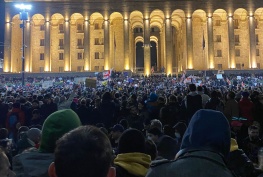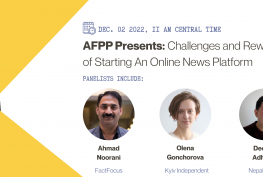By Emran Hossain
As the coverage of the recent, tragic collapse of a multistory building in Bangladesh underscores, journalists around the world – and in the U.S. – may be well-served by not only exercising skepticism and caution about timely facts, but, more important, also to ask themselves if they’re too eager to accept the official version of events unfolding before their very eyes.
After the eight-story garment factory fell, the first and chief concern, of course, became the fate of those trapped in the debris.
Initial dispatches about the April 24 incident by Bangladeshi news outlets estimated the number of trapped workers at not less than 5,000. That figure was based on testimony from often-tearful survivors in tatters talking with reporters from different media outlets at the chaotic scene at Savar, only 40 kilometers from the capital, Dhaka.
After two days, as rescuers fought against time to pull out survivors, several Bangladeshi news outlets suddenly and sharply reduced the number of trapped workers to roughly 3,000, even before the government and rescuers produced an estimate. This dramatic downgrade of the tragedy’s toll went unexplained and unsourced by news outlets. Rescuers soon thereafter announced their search for survivors had ended and they estimated that the number of trapped workers would not exceed 3,300. This announcement came after 2,500 workers had been pulled from the rubble and the death toll had crossed 500.
Relatives of the victims then clashed with police as the list of the missing rose to 1,300. Bangladeshi media ignored the protests, which, eventually, drew international media attention. Reporters told of victims’ claims that the government had concealed bodies of the dead; confidence in officials’ statements was undercut by the plodding rescue effort, which proceeded at snail’s pace for more than two weeks.
In the time since, as many as 1,200 bodies have been recovered, making the number of workers trapped in this calamity closer to 4,000; several hundred people managed to escape on their own shortly after the factory fell.
Why did Bangladeshi media choose to be inaccurate and to report the much lower toll, even though they clearly had more appropriate information at the outset? How could they ignore facts produced by their own reporting on the scene? Were they pressured by the government? Did businessmen buy their integrity?
I don’t think so.
Media outlets made their own decisions. But, as is true around the globe, those with education, affluence and power speak with authority. Reporters and editors give greater credibility to officials than the poor. Those who huddle in poverty or who earn a pittance for a daily wage (as is the case with garment factory workers) do not get a voice in Bangladeshi media, unless they are killed in the hundreds.
Though they had powerful information to share – including how they saved their own and others’ lives and how they were woefully exploited — the poor were denied, again, their rare chance to speak up in the factory collapse saga. Reporters, editors and media outlets in Bangladesh all too quickly fell in line with the official line; they showed their allegiance to the government or to politicians they trust or to powerful business interests. In Bangladesh, all major and influential news outlets are owned by such business interests or by politicians. So, self-censorship is a predominant practice. Press freedom — or what should be its limits — gets discussed only when rival news outlets publish scandalous reports about each other. Is this what freedom of the press really means?
Bangladesh’s current experience illustrates that visible intervention by parties outside the media is not required to threaten press freedom. Indeed, laws to protect press freedom even can end up shielding media abuses in an established system.
Lest my kind and generous American colleagues get too smug about their own press practices, I don’t see much difference in what prevails in Bangladesh versus what happens in the USA. Business interests, in fact, are more powerful here. Corporatized media has become the norm in America, with television networks, newspaper chains and online media owned and operated by giant companies for maximum profit and self-interest. During elections, they support specific candidates or parties. American broadcasters, far more than their Bangladeshi counterparts, profit lavishly from political and special interest advertising; newspapers campaign on their Editorial and Op-Edit pages for the National Rifle Association — even though it already may be America’s most powerful lobby group — on the grounds that freedom entitles every individual to own a gun for his own protection, no matter the daily rising toll of gun violence.
Since my arrival in mid-March, I struggle to recall any detailed story in the major media I consume discussing the struggles and plight of the impoverished in rural, agricultural America or the baleful conditions confronting this nation’s urban poor. Can we really believe that deplorable workplace practices – which once launched and fueled a remarkable labor movement in the U.S. – have vanished, to be replaced only by cartoon-like avaricious teachers or public employees and their unions?
The American media I see is obsessed, instead, with endless reports on arguing politicians, power plays by tycoons and celebrities indulging themselves in unimaginable ways. I don’t find pieces critically analyzing American foreign policy and the widening U.S. role in waging war globally in the name of combatting terrorism; we know, instead, from painful backward examinations just how readily the press served powerful interests in pressing, wrongfully, the case for the war in Iraq.
Noam Chomsky, the famed American intellectual, demanded the media be held to a higher standard of critical self-examination, especially because it too often “does not know what it does not know.” He criticized American media for failing to run a single story on how the U.S. military mistreated journalists in countries like Nicaragua and Guatemala during this nation’s interventions in Central America.
Despite the chiding, warning voices, American journalists I have talked to remain convinced that they work freely. “I can write whatever I can think of,” said one. Oh, really? I’m grateful that my Friendly Fellowship gives me time and the opportunity to step back and think about the media, its place in society and its need to speak truth at times to power. It occurs so rarely and desperately needs to happen more.




